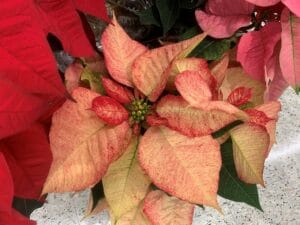Hello fellow readers, The other day, while shopping for groceries, I stumbled upon an array of poinsettia varieties arranged at the floral department entrance. Hopefully not annoying other shoppers, I snagged a bunch of photos to capture their beauty. Of course, there were the traditional red and white ones. Intermingled within were cream-colored poinsettias and one mottled pink with what looked like red paint spatters. You know, how they taught you in art class as a kid using a toothbrush?
Then there were salmon-colored ones that stood out from the norm. I snooped through the foliage, looking for identification of the unusual varieties, to no avail. And so, photos in hand, I searched the internet to find out who’s who.
There are over a hundred poinsettias varieties.
Native to Mexico, it’s hard to imagine there are now over a hundred types of poinsettias (Euphorbia pulcherrima) that decorate our world—mottled, marbleized, and solids all propagated to be that way. Other than the cream-colored ones painted with blue or purple splashes to trick us. Though there is one with solid purply bracts called ‘Plum Pudding.’ Of course, the sparkly ones are an added glam that makes the plant look somewhat artificial.
The rabbit hole of investigative googling narrowed the beauties down to a few likely varieties. The only for sure identification was ‘Winter Rose Early Red’ with puckered up bracts. Bracts, by the way, are the modified leaves that provide the color we adore. Mother Nature designed them to lure pollinators to the tiny flowers in the center.
A rose lookalike poinsettia variety is odd but intriguing.
As the name suggests, ‘Winter Rose Early Red’ has a rose-like appearance. The dark green leaves curl under as well, making the plant compact. Maybe because I’m not a rose person, too fussy, I find the rose lookalike not so pretty though intrigued by its uniqueness.
The solid white poinsettia with dark green leaves is likely either ‘Whitestar’ or ‘Polar Bear.’ Though I read that Whitestar’s bracts resemble doves the way they flare out. And so, I’m going to tag the pure white one ‘Polar Bear’ Besides; the name is cuter.
‘White Wonder’ is possibly the creamy white one. The modified leaves are so large you barely can see the dark green leaves below. Some of the bracts have green veins or have stripes of a mottled green.
Then there was the pinkish, almost salmon-colored one, most likely ‘Cinnamon Star.’ I adore how the younger leaves are darker in hue. ‘Christmas Glory Pink,’ similar in color, has red veins, and some leaves are red.
“Best of Show” of the bunch.
The best of the show in unusualness of the bunch, with cherry red paint spattering on a pinkish-creamy background, is ‘Premium Picasso.’ The newer bracts sport more red paint, and the outer ones have only a few splatters. Still, there’s something about the tradition of one of the most commonly sold varieties, ‘Prestige Red.’
Speaking of tradition, I recall the first time seeing poinsettias growing outside in Florida while walking the neighborhood with my folks who lived in New Smyrna Beach. Poinsettias were as tall as the single-story houses! In the thirty years that they lived there, I only missed one Christmas but made it down the day after—how I miss the traditions.
Christmas indeed brings memories of times gone by. And it can be hard to celebrate the glory of the season when those we love are no longer around us. But we all can be home for Christmas if only in our dreams.
Garden Dilemmas? AskMaryStone@gmail.com (and now on your favorite Podcast App.)
You’ll enjoy a previous column about the History & Legend of Poinsettias. … and the corresponding Podcast:
Did you know? Poinsettias are not highly toxic despite their bad reputation. True, the white sap, the latex in the circulation system, may irritate sensitive folks’ skin or cause diarrhea or vomiting if eaten (why would you?). Some pets or children may not know better, though they’re not very tasty. The American Association of Poison Control Centers reports no fatalities in children, and most often, poinsettia eaters don’t require medical treatment. The same is true for cats and dogs per the Pet Poison Helpline.
American Association of Poison Control Centers





